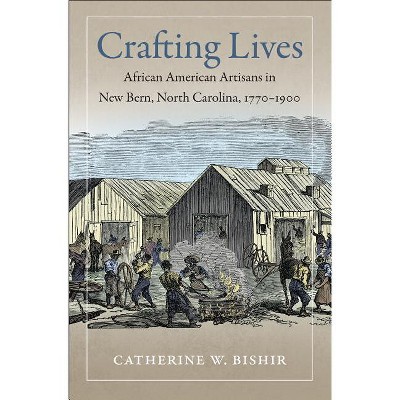Main Street in Crisis - by Catherine McNicol Stock (Paperback)

About this item
Highlights
- This study of class during the Great Depression is the first to examine a relatively neglected geographical area, the northern plains states of North and South Dakota, from a social and cultural perspective.
- About the Author: Catherine McNicol Stock is associate professor of history and director of the American studies program at Connecticut College.
- 320 Pages
- Social Science, Sociology
Description
About the Book
Main Street in Crisis: The Great Depression and the Old Middle Class on the Northern PlainsBook Synopsis
This study of class during the Great Depression is the first to examine a relatively neglected geographical area, the northern plains states of North and South Dakota, from a social and cultural perspective. Surveying the values and ideals of the old middle class -- independent shopkeepers, artisans, professionals, and farmers -- Catherine Stock presents a picture of Dakotans' cultural life in the 1920s and 1930s and tells of their efforts to come to terms with the enormous social change brought about by the New Deal.According to Stock, the depression not only destroyed Dakotans' economic foundations but also bankrupted their community organizations and undermined theirsocial relations. She shows that Dakotans' social values, characterized by notions of neighborliness, loyalty, hard wok, upright character, and individual enterprise, were threatedened first by devastating drought and subsequent economic collapse and then by massive relief efforts and governmental intervention on an unprecedented scale. By 1940, one-third of all farmers who owned their land had lost it to foreclosure, and the federal government had spent nearly half a billion dollars to aid the region.
Stock argues that to Dakotans, the New Deal offered a trade-off between autonomy, community, and local control, on the one hand, and survival itself on the other. Dakotans, ambivalent toward "progress," feared not only for their land, their businesses, their families, and their communities; they feared for the survival of a way of life. They responded, says Stock, by working to make sense of the new world and find renewed meaning in the old.
Consulting varied sources such as diaries, autobiographies, oral histories, and newspaper accounts, Stock includes women's voices as well as men's. She integrates female perspectives on farm life and old-middle-class community into the narrative as a whole and devotes a separate chapter to women's experiences of the upheavals produced by the Great Depression and the New Deal.
From the Back Cover
This study of class during the Great Depression is the first to examine a relatively neglected geographical area, the northern plains states of North and South Dakota, from a social and cultural perspective. Surveying the values and ideals of the old middle class--independent shopkeepers, artisans, professionals, and farmers--Catherine Stock presents a picture of Dakotans' cultural life in the 1920s and 1930s and tells of their efforts to come to terms with the enormous social change brought about by the New Deal. According to Stock, the depression not only destroyed Dakotans' economic foundations but also bankrupted their community organizations and undermined their social relations. She shows that Dakotans' social values, characterized by notions of neighborliness, loyalty, hard work, upright character and individual enterprise, were threatened first by devastating drought and subsequent collapse and then by massive relief efforts and governmental intervention on an unprecedented scale. By 1940, one-third of all farmers who owned their land had lost it to foreclosure, and the federal government had spent nearly half a billion dollars to aid the region. Stock argues that to Dakotans, the New Deal offered a trade-off between autonomy, community, and local control, on the one hand, and survival itself on the other. Dakotans, ambivalent toward "progress", feared not only for their land, their businesses, their families, and their communities; they feared for the survival of a way of life. They responded, says Stock, by working to make sense of the new world and find renewed meaning in the old. Consulting varied sources such as diaries, autobiographies, oral histories, and newspaperaccounts, Stock includes women's voices as well as men's. She integrates female perspectives on farm life and old-middle-class community into the narrative as a whole and devotes a separate chapter to women's experiences of the upheavals produced by the Great Depression and the New Deal.Review Quotes
[A] thoughtful, even wise, book.
"Journal of American History"
ÝA¨ thoughtful, even wise, book.
"Journal of American History"
An imaginatively researched, well-written, provocatively argued book that will begin to fill a vacuum in our knowledge.
Lawrence Levine, University of California, Berkeley
An outstanding book, one with implications that go far beyond its chronological and geographical borders.
"Canadian Review of American Studies"
"[A] thoughtful, even wise, book.
"Journal of American History""
"An imaginatively researched, well-written, provocatively argued book that will begin to fill a vacuum in our knowledge.
Lawrence Levine, University of California, Berkeley"
"An outstanding book, one with implications that go far beyond its chronological and geographical borders.
"Canadian Review of American Studies""
An outstanding work of scholarship that fills an important void in our understanding of the Depression decade.
"Journal of the West"
Stock's provocative analysis deserves the widest readership.
"American Historical Review"
About the Author
Catherine McNicol Stock is associate professor of history and director of the American studies program at Connecticut College.Shipping details
Return details
Trending Poetry











